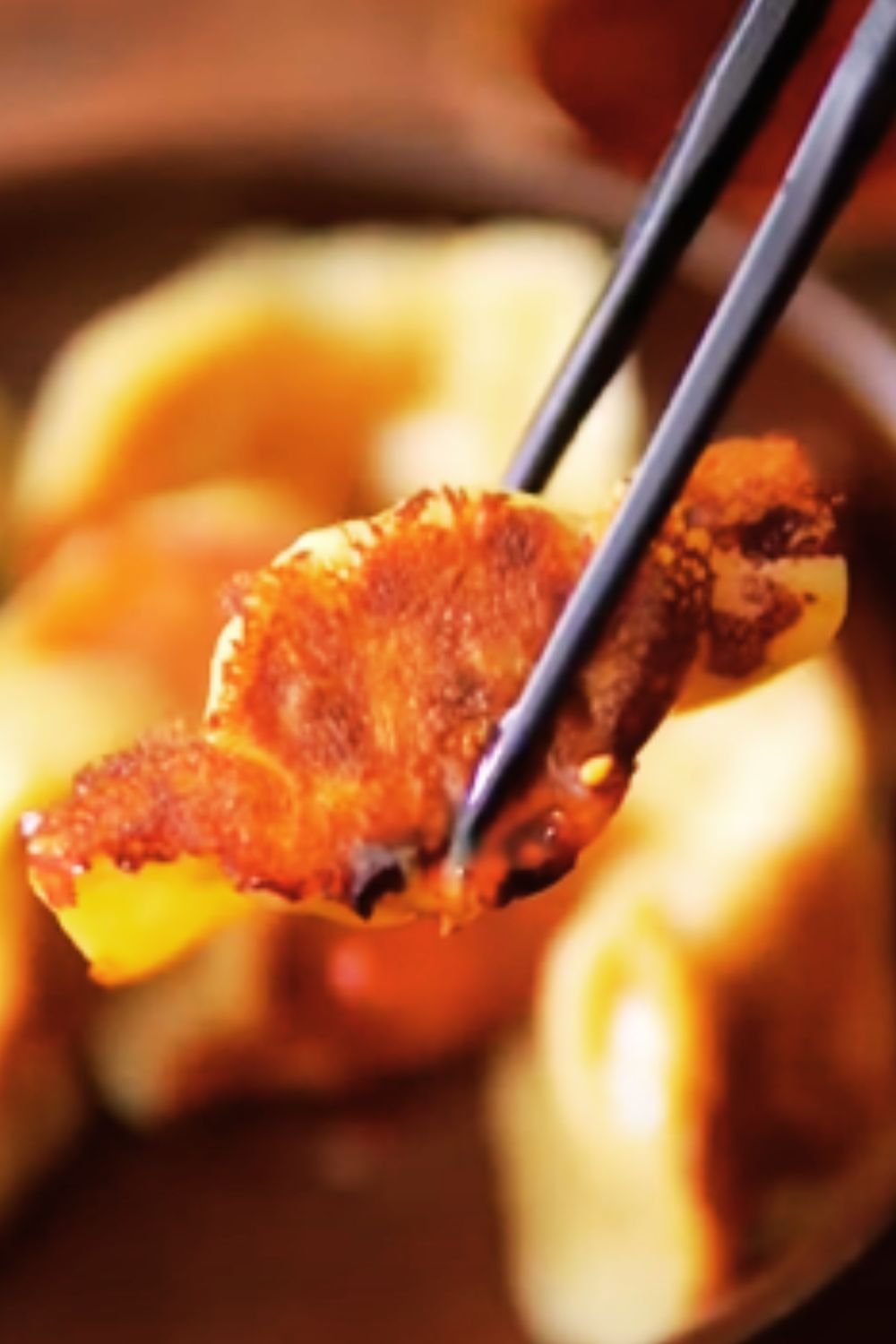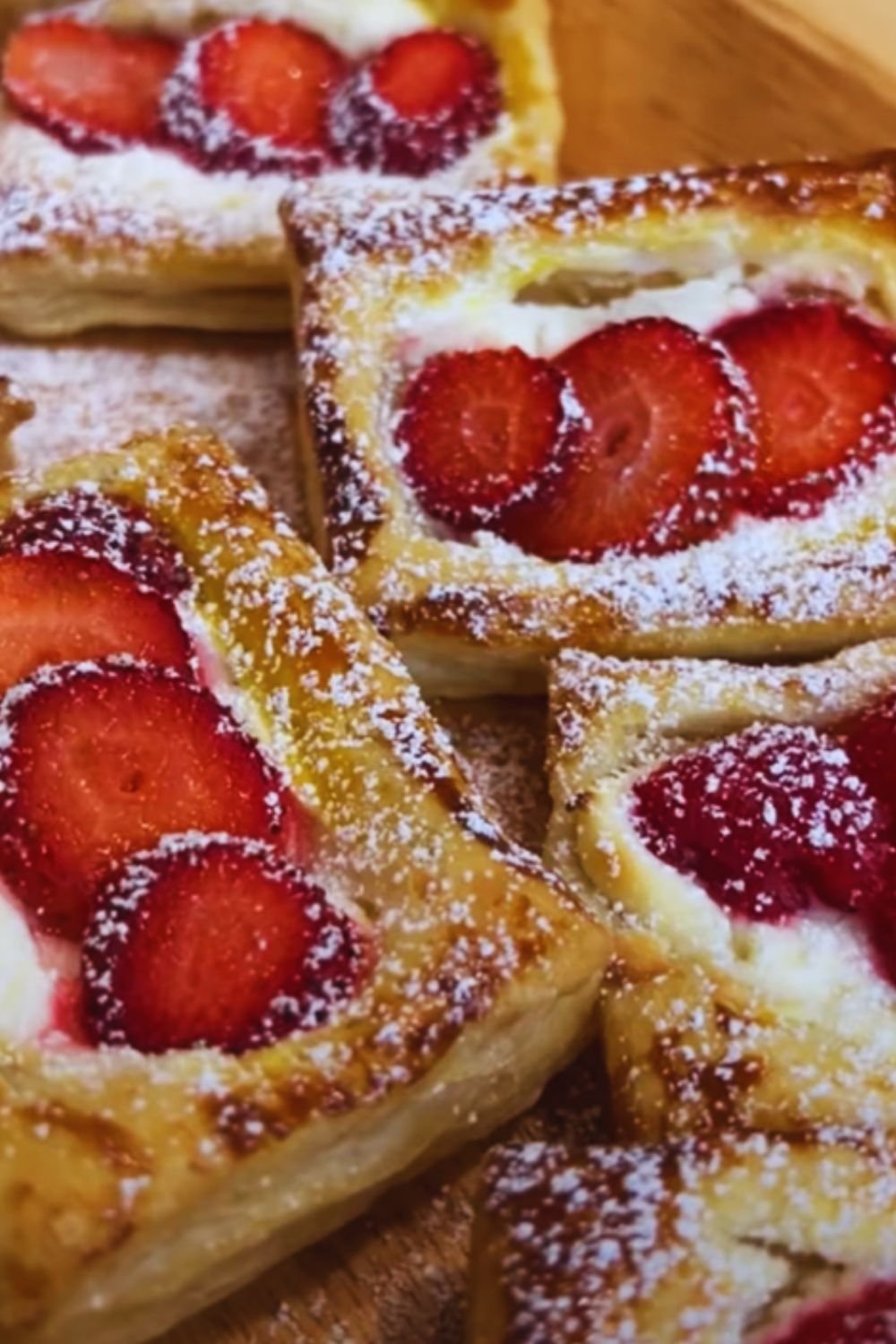There’s something deeply satisfying about making dumplings from scratch. The rhythmic folding, the aromatic filling, the anticipation of that first bite—it’s a culinary experience that connects us to centuries of tradition. I’ve been making pork and chives dumplings for over a decade, and I’m still amazed at how such simple ingredients can create something so deeply flavorful. Today, I’m sharing my comprehensive guide to crafting these little pockets of joy in your own kitchen.
The Cultural Significance of Dumplings
Dumplings aren’t just food—they’re cultural artifacts that carry stories across generations. In Chinese culture, dumplings (jiaozi) symbolize wealth and prosperity due to their resemblance to ancient gold ingots. They’re particularly prominent during Lunar New Year celebrations, when families gather to make them together.
The earliest recorded dumplings date back to the Han Dynasty in China (206 BCE–220 CE), credited to a physician named Zhang Zhongjing. Legend has it that he created “ear-shaped” dumplings filled with warming ingredients to help people suffering from frostbitten ears during a particularly harsh winter.
What started as medicinal food evolved into one of the most beloved dishes across East Asia, with countless regional variations. The combination of pork and chives remains one of the most traditional and popular fillings, representing the perfect balance of rich meat and fragrant vegetables.
Essential Ingredients for Authentic Pork and Chives Dumplings
The beauty of dumplings lies in their simplicity. While there are countless variations, the classic pork and chives combination relies on a handful of high-quality ingredients:
For the Dough
- High-gluten flour: Creates the perfect chewy texture
- Water: The temperature matters—warm water makes softer dough, while cold water creates more elasticity
- Salt: Just a pinch to enhance flavor
For the Filling
- Ground pork: Preferably shoulder with at least 20% fat content for juiciness
- Chinese chives (jiucai): More pungent than regular chives, with flatter blades
- Shaoxing wine: Adds depth and complexity
- Sesame oil: For that distinctive nutty aroma
- White pepper: Provides subtle heat without overpowering
- Salt and sugar: To balance flavors
- Ginger: Fresh, grated for bright, zingy notes
- Garlic: Minced finely to distribute evenly
- Scallions: For additional layers of onion flavor
- Light soy sauce: Adds umami and color
- Water or stock: Creates the signature juicy interior
For the Dipping Sauce
- Black vinegar (Chinkiang vinegar): The foundation of any good dumpling sauce
- Soy sauce: Adds saltiness and umami
- Chili oil: For heat lovers
- Garlic: Minced or grated
- Ginger: Freshly grated
- Sesame oil: Just a few drops
- Sugar: A pinch to balance acidity
Making the Perfect Dumpling Dough
While store-bought wrappers are convenient, nothing compares to homemade dough. The process is surprisingly simple, though it requires some patience and practice.
Basic Dumpling Dough Recipe
| Ingredient | Quantity | Notes |
|---|---|---|
| All-purpose flour | 300g (2½ cups) | High-gluten preferred |
| Water | 150-165ml (⅔ cup) | Adjust as needed |
| Salt | ½ teaspoon | Optional but recommended |
Step-by-Step Dough Making Process
- Prepare the flour: Sift flour and salt into a large mixing bowl, creating a well in the center.
- Add water gradually: Pour about half the water into the well and begin mixing with chopsticks or a fork.
- Continue adding water: Add remaining water bit by bit until the dough starts to come together.
- Knead the dough: Transfer to a floured surface and knead for 8-10 minutes until smooth and elastic.
- Rest the dough: Wrap in plastic and rest at room temperature for at least 30 minutes (ideally 1-2 hours).
- Divide and roll: Cut the dough into equal portions and roll into small balls (about 20-25g each).
- Form wrappers: With a small rolling pin, roll each ball from the edge toward the center, rotating as you go, to create a 3-3.5 inch wrapper that’s thinner at the edges and slightly thicker in the center.
The resting period is crucial—it allows the gluten to relax, making the dough easier to roll and resulting in a better texture after cooking.
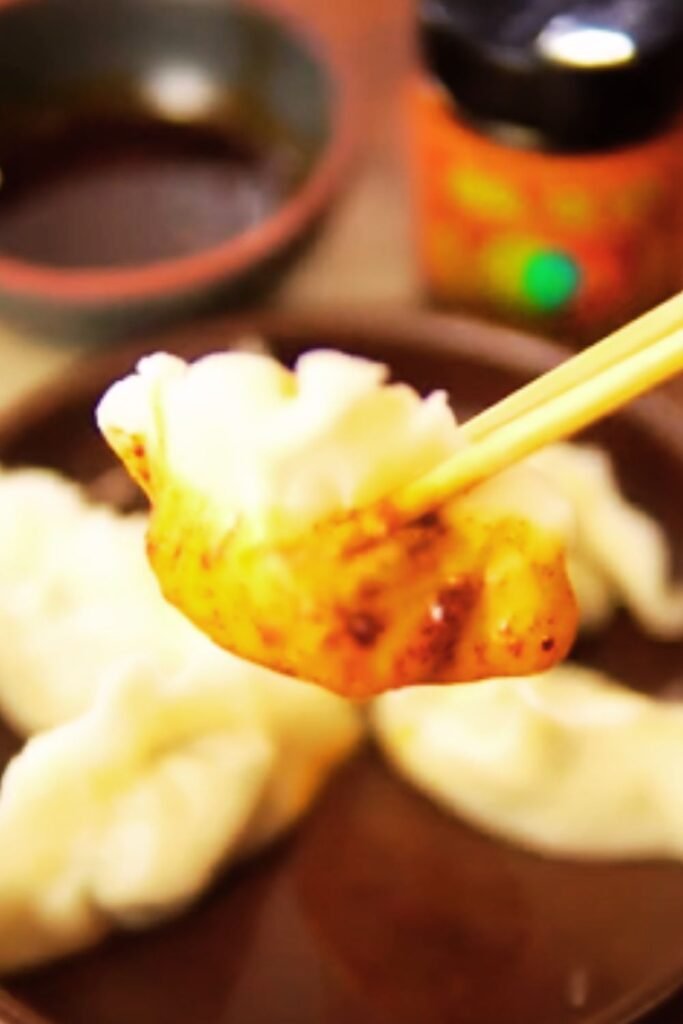
Creating the Perfect Pork and Chives Filling
The filling is where the magic happens. The key is balancing flavors and textures while ensuring everything is well-incorporated.
Classic Pork and Chives Filling Recipe
| Ingredient | Quantity | Purpose |
|---|---|---|
| Ground pork | 500g (1 lb) | Main protein, preferably 70-80% lean |
| Chinese chives | 200g (about 2 cups), finely chopped | Signature flavor |
| Shaoxing wine | 2 tablespoons | Depth of flavor |
| Sesame oil | 1 tablespoon | Aroma |
| White pepper | ½ teaspoon | Subtle heat |
| Salt | 1 teaspoon | Seasoning |
| Sugar | ½ teaspoon | Balances flavors |
| Ginger | 1 tablespoon, finely grated | Brightness |
| Garlic | 3 cloves, minced | Pungency |
| Scallions | 3, finely chopped | Layered onion flavor |
| Light soy sauce | 1 tablespoon | Umami and color |
| Water or stock | ⅓ cup | Creates juiciness |
The Science of a Juicy Filling
The secret to exceptionally juicy dumplings lies in how you mix the filling. Here’s my foolproof method:
- Start with cold ingredients: Keep your ground meat refrigerated until ready to use.
- Mix in one direction: Stir the meat mixture consistently in one direction to develop protein bonds.
- Add liquid gradually: Slowly incorporate water or stock while continuing to stir in the same direction.
- Test for consistency: The mixture should be sticky and hold together well.
- Add vegetables last: Mix in chives just before filling to prevent excess moisture from leaking out.
- Let it rest: Allow the filling to marinate for 30 minutes to an hour for flavors to meld.
The technique of mixing in one direction helps create a sticky, bouncy texture in the cooked filling by developing the myosin in the meat—the same protein that gives good sausages their signature texture.
The Art of Dumpling Folding
Folding dumplings is both functional and artistic. While there are dozens of traditional folding styles, I’ll share three classic techniques that balance beauty and practicality.
Basic Crescent Fold (Half-Moon)
The simplest fold, perfect for beginners:
- Place a spoonful of filling in the center of the wrapper.
- Fold in half to create a half-moon shape.
- Pinch the center of the edge to seal.
- Work your way outward, pinching to seal completely.
Pleated Crescent
The most common restaurant-style fold:
- Place filling in the center of the wrapper.
- Fold in half but don’t seal completely.
- Starting from one end, create small pleats along the edge, pressing to seal.
- Aim for 5-7 pleats for a medium-sized dumpling.
Standing Pouch (Shui Jiao)
Ideal for boiled dumplings:
- Place filling in the center of the wrapper.
- Pinch together the wrapper at the center, creating a taco-like shape.
- Create pleats on both sides, working from the center outward.
- Ensure the bottom has a flat surface so the dumpling can stand upright.
Tips for Perfect Folds
- Keep a small bowl of water nearby to moisten the edges if needed.
- Don’t overfill—about 1 tablespoon of filling per wrapper is ideal.
- Cover finished dumplings with a clean, damp towel to prevent drying.
- Work with a few wrappers at a time, keeping the rest covered.
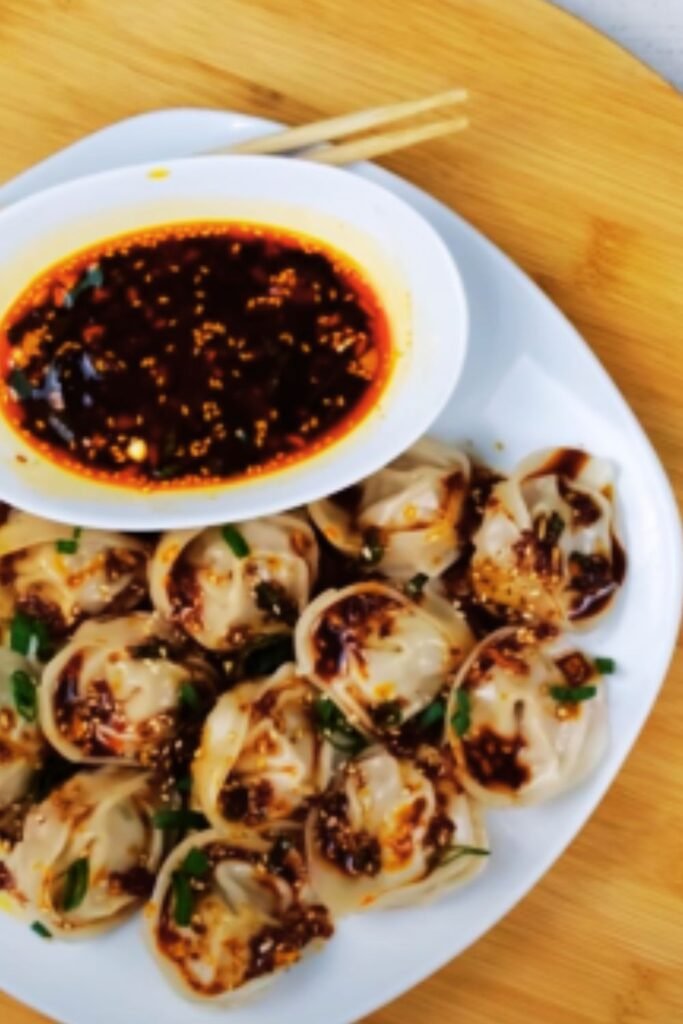
Cooking Methods: Steamed, Boiled, or Pan-Fried?
Each cooking method creates a distinctly different dumpling experience. I recommend trying all three to discover your preference.
Steaming (Zheng Jiao)
Steaming preserves the delicate flavors and creates a tender skin:
- Line a bamboo steamer with parchment paper, cabbage leaves, or cloth.
- Arrange dumplings with space between them.
- Steam over boiling water for 8-10 minutes.
- Allow to rest for 2 minutes before serving.
Boiling (Shui Jiao)
Boiling creates a slippery, chewy texture:
- Bring a large pot of water to a rolling boil.
- Add dumplings carefully, stirring gently to prevent sticking.
- When water returns to a boil, add ½ cup cold water.
- Repeat this process three times (three boils total).
- Dumplings are done when they float and look swollen.
Pan-Frying (Guo Tie/Pot Stickers)
Creates a wonderful contrast between crispy bottom and tender top:
- Heat 1-2 tablespoons oil in a non-stick pan over medium heat.
- Arrange dumplings flat-side down, close together but not touching.
- Fry until bottoms are golden (2-3 minutes).
- Add ⅓ cup water, immediately cover with a lid.
- Steam for 6-8 minutes until water evaporates.
- Cook uncovered for another minute to re-crisp the bottoms.
Comparison of Cooking Methods
| Method | Texture | Cooking Time | Best Wrapper Type | Ideal Filling | Notes |
|---|---|---|---|---|---|
| Steaming | Tender, slightly chewy | 8-10 minutes | Thin, homemade | Delicate flavors | Preserves the most flavor |
| Boiling | Slippery, very chewy | 5-8 minutes | Medium thickness | Robust flavors | Most traditional method |
| Pan-frying | Crispy bottom, soft top | 10-12 minutes | Medium to thick | Higher fat content | Creates textural contrast |
Perfect Dipping Sauce Combinations
A great dipping sauce can elevate your dumpling experience. Here are three classic options:
Traditional Black Vinegar Sauce
The most classic pairing for pork and chives dumplings:
- 2 tablespoons Chinkiang black vinegar
- 1 tablespoon light soy sauce
- ½ teaspoon sugar
- 1 teaspoon sesame oil
- 1 teaspoon grated ginger
- 1 clove garlic, minced
Mix all ingredients and let sit for at least 10 minutes before serving.
Spicy Chili Oil Sauce
For those who enjoy heat:
- 2 tablespoons chili oil with sediment
- 1 tablespoon black vinegar
- 1 teaspoon light soy sauce
- ½ teaspoon sugar
- 1 scallion, finely chopped
Simple Ginger-Scallion Sauce
Clean, bright flavors:
- 2 tablespoons finely minced scallions
- 1 tablespoon grated ginger
- 2 tablespoons neutral oil
- Pinch of salt
Heat oil until very hot, then pour over ginger and scallions. The heat will release their aromas.
Troubleshooting Common Dumpling Problems
Even experienced dumpling makers encounter challenges. Here are solutions to the most common issues:
Dough Problems
- Too sticky: Add more flour, a little at a time.
- Too dry: Wet your hands slightly and continue kneading.
- Wrappers drying out: Keep covered with a damp towel at all times.
- Difficult to roll: Let the dough rest longer to relax the gluten.
Filling Issues
- Too wet: Add a small amount of cornstarch to absorb excess moisture.
- Filling leaking during cooking: Ensure edges are properly sealed and avoid overfilling.
- Bland flavor: Add more salt, white pepper, or a dash of MSG.
- Tough texture after cooking: You may have overmixed or used meat that’s too lean.
Cooking Challenges
- Dumplings sticking together: Make sure they don’t touch when first added to water or steamer.
- Wrappers breaking during boiling: Your water may be boiling too vigorously.
- Soggy bottoms on pot stickers: Make sure all water has evaporated before the final crisping stage.
- Undercooked filling: Increase cooking time and ensure pieces of meat are finely ground.
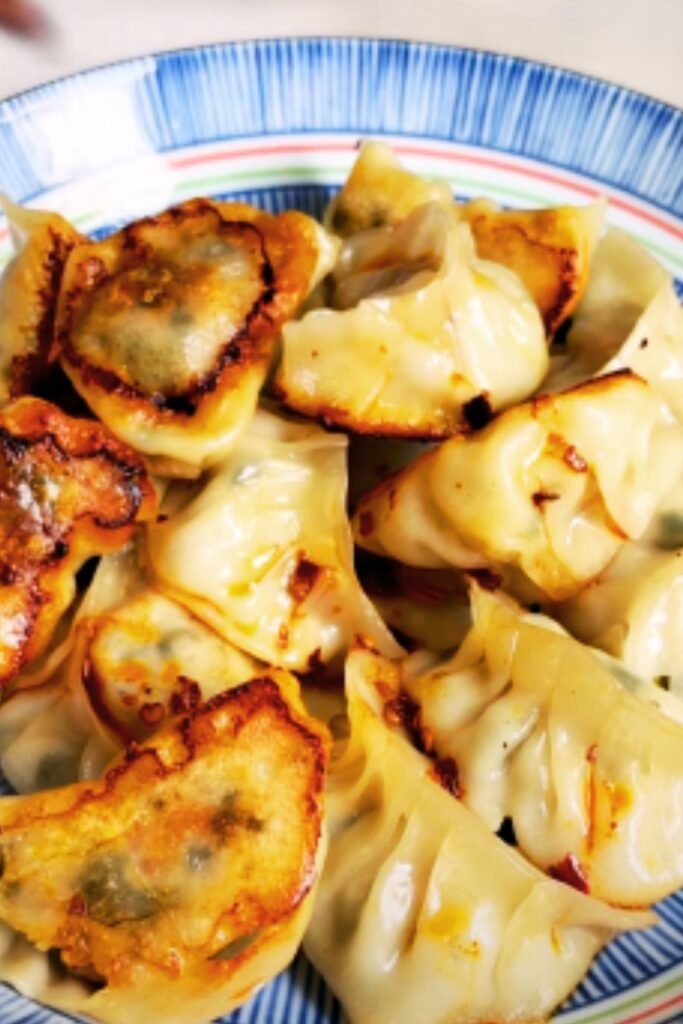
Serving Suggestions and Accompaniments
Dumplings can be served as appetizers, main courses, or part of a larger spread. Here are some ideas for creating a complete meal:
As Part of a Chinese Meal
Serve alongside:
- Hot and sour soup
- Stir-fried greens (bok choy, gai lan, or Chinese broccoli)
- Steamed white rice
- Cucumber salad with vinegar dressing
As a Complete Meal
Turn dumplings into a satisfying meal with:
- A simple broth (clear chicken or vegetable)
- Quick-pickled vegetables
- Edamame or another simple protein side
- Steamed greens with garlic
Garnishes to Elevate Presentation
- Thinly sliced scallions
- Toasted sesame seeds
- Small cilantro leaves
- Thin slices of red chili
- Microgreens or sprouts
Storing and Freezing Homemade Dumplings
One of the best things about making dumplings is that they freeze beautifully, allowing you to enjoy them whenever a craving strikes.
Freezing Raw Dumplings
- Arrange on a tray: Place uncooked dumplings on a parchment-lined baking sheet, not touching.
- Flash freeze: Place the entire tray in the freezer for 1-2 hours until completely frozen.
- Transfer to storage: Once frozen solid, transfer to airtight containers or freezer bags.
- Label clearly: Note the date and filling type.
Properly stored, frozen dumplings will maintain quality for up to 3 months.
Cooking From Frozen
- Steaming: Add 2-3 minutes to normal steaming time.
- Boiling: No need to defrost; simply add directly to boiling water and cook until they float.
- Pan-frying: Start with the standard method but add a bit more water and increase covered steaming time by 2-3 minutes.
Storing Leftovers
- Cooked dumplings: Refrigerate for up to 3 days.
- Dumpling dough: Wrap tightly in plastic and refrigerate for up to 2 days.
- Filling mixture: Keep refrigerated for no more than 24 hours before using.
Health and Nutritional Considerations
Traditional dumplings can be adapted to suit various dietary needs without sacrificing flavor.
Nutritional Profile of Standard Pork and Chives Dumplings
| Component | Amount per 5 dumplings | % Daily Value |
|---|---|---|
| Calories | 350-400 | 17-20% |
| Protein | 15-18g | 30-36% |
| Carbohydrates | 45-50g | 15-17% |
| Fat | 12-15g | 18-23% |
| Sodium | 600-800mg | 26-35% |
| Fiber | 2-3g | 7-11% |
Healthier Adaptations
- Lower carb: Use thinner wrappers or wonton wrappers instead of thick dumpling skins.
- Higher protein: Increase the meat-to-wrapper ratio or add egg whites to the filling.
- Lower sodium: Reduce soy sauce and salt, compensating with ginger, garlic, and white pepper.
- Gluten-free: Rice flour or tapioca starch wrappers can work, though they’re more delicate.
Vegetarian and Vegan Options
Replace pork with:
- Tofu (pressed firm) and mushrooms
- Tempeh and cabbage
- Seitan with chopped nuts for texture
- Plant-based ground meat alternatives
Q&A Section: Your Dumpling Questions Answered
Q: Why do my dumpling wrappers keep breaking when I try to fold them?
This usually happens when the edges of your wrappers are too dry. Keep a small bowl of water nearby and lightly moisten the edges with your fingertip before folding. Also, make sure you’re not rolling the wrappers too thin—they should be about 1mm thick for proper structure.
Q: Can I make the dough and filling in advance?
Yes, but with some precautions. The dough can be made up to 24 hours ahead and stored in the refrigerator, tightly wrapped in plastic. Let it come to room temperature before rolling. The filling can be prepared up to 24 hours in advance and kept refrigerated. I don’t recommend mixing the chives in until you’re ready to fill the dumplings, as they can release water and affect the texture.
Q: Why are my pot stickers sticking too much to the pan?
This typically happens when either your pan isn’t hot enough before adding the dumplings or you’re using the wrong type of pan. Use a good-quality non-stick pan or a well-seasoned cast iron pan. Make sure the oil is hot before adding the dumplings, and don’t try to move them until they’ve developed a proper crust.
Q: How can I tell when boiled dumplings are done?
Properly cooked boiled dumplings will float to the surface and look slightly swollen. The wrappers will appear somewhat translucent rather than opaque. If you’re unsure, remove one dumpling, cut it in half, and check that the filling is cooked through with no pink remaining for meat fillings.
Q: My steamed dumplings keep sticking to the steamer. How can I prevent this?
Always line your steamer before adding dumplings. You can use parchment paper with small holes punched in it, cotton cloth that’s been dampened, or natural liners like cabbage or lettuce leaves. If using bamboo steamers, you can also lightly oil the slats, though this is less ideal as it can make the dumplings greasy.
Q: Can I use regular American chives instead of Chinese chives?
You can, but the flavor profile will be different. Chinese chives (jiucai) have a stronger, more garlicky flavor and flatter blades. If using regular chives, you might want to add a bit more garlic to compensate for the milder flavor. You could also substitute with a mixture of regular chives and garlic chives (if available) or leeks for a somewhat similar effect.
Final Thoughts: The Joy of Dumpling Making
Making dumplings is more than just cooking—it’s a meditative practice that connects us to culinary traditions spanning thousands of years. The process invites us to slow down, to focus on repetitive, careful movements, and to take pride in creating something both beautiful and delicious.
In many Chinese families, dumpling making is a communal activity, with multiple generations gathering around a table to fold while sharing stories. Even when making them alone, there’s something deeply satisfying about transforming simple ingredients into dozens of perfectly pleated parcels.
As you practice, you’ll develop your own rhythm and style. Your folds will become more confident, your filling better balanced, and your cooking more intuitive. Embrace the journey—there’s always something new to learn in the wonderful world of dumplings.
Whether you’re making them for a special celebration or a cozy weeknight dinner, homemade pork and chives dumplings bring a touch of culinary magic to any table. Now, roll up your sleeves, dust your counter with flour, and begin the delicious adventure!
